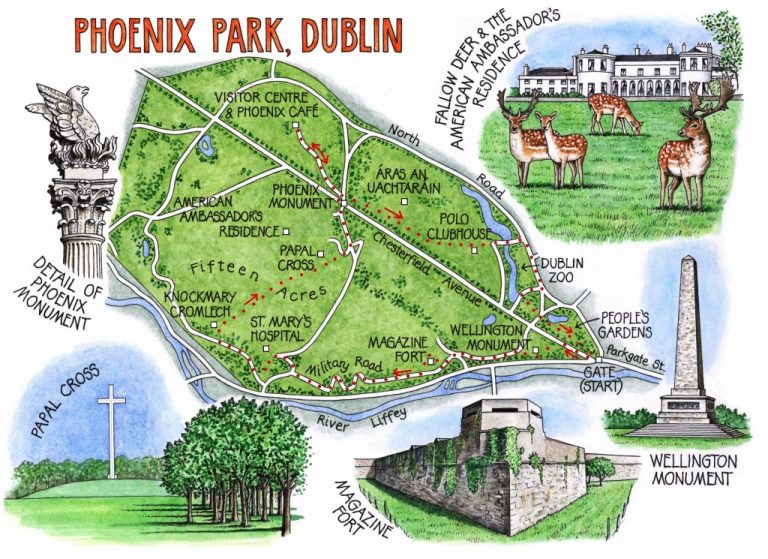 Irish Independent Walk of the Week Christopher Somerville
Irish Independent Walk of the Week Christopher Somerville
9 July 2011
No 103: Phoenix Park, Dublin
The Phantom Warbler of Thomas’s Hill was in good voice this morning. A shadowy figure in the morning mist, he passed among the oaks like a wraith, trailing an unearthly falsetto behind him. Maybe it was the muted light before the low sun broke through into Phoenix Park, or perhaps an emanation issuing from the grim old Magazine Fort lying blackly at the nape of the hill, but the apparition and his wordless lament succeeded in raising the hairs on the neck of your correspondent.
Behind me the great stone needle of the Wellington Monument stood cradled by trees. Dublin took several decades to erect this obelisk of honour to its native son Arthur Wellesley, Duke of Wellington, violet-eyed and hawk-beaked, victor of Waterloo, the shrewdest cookie in Queen Victoria’s basket of advisers. When sparrows resident in the treetops inside London’s Crystal Palace threatened to ruin the clothes of Great Exhibition visitors with their droppings, the organisers were in despair – guns were no use in a glass building. Her Majesty put the problem before the 81-year-old Wellington. His advice was crisp and to the point: ‘Sparrowhawks, ma’am!’
I marched a round of the moated fort, then made west along the Corkscrew Road. Below me the River Liffey chattered and sparkled. An eight-oared boat sculled upstream, leaving brilliants in its wake. Kilmainham Gaol beyond was softened in muted greys while the city skyline to the east was a blur of faint blue domes and spires. Ahead I made out a dreamy hint of the Dublin Mountains. What a morning to be walking in Phoenix Park.
Phoenix is the largest walled city park in Europe, a mighty 1,750 acres, larger than many a town, the setting for more historic rallies, duels, celebrations and speeches than you could shake a stick at. Dubliners take it entirely for granted, this giant green lung of theirs; but for visitors getting to know the fair city it comes as a shock, a delightful one, to have so much open space on the doorstep for sport and play.
By the barrack-like wall of St Mary’s Hospital I climbed a grassy slope and passed the knee-high tomb slabs of Knockmary Cromlech, tiny enough to call Spinal Tap’s Stonehenge to mind. The image raised a rather childish smirk as I walked out into the vast grass prairie of the Fifteen Acres.
Now signs and wonders pressed in to claim attention – the enormous white crucifix, taller than a tower block, erected on the mound where Pope John Paul II said Mass on 29 September 1979 in the sight of half the people of Ireland; the grand white wedding-cake mansions that house the American Ambassador to Ireland and this country’s President; the fierce stone phoenix rearing skyward from the peak of Lord Chesterfield’s monument. Here was the spot where the revolutionary Invincibles slew Chief Secretary Lord Frederick Cavendish and Under Secretary Thomas Burke on 6 May 1882 as they strolled in the park. There lay the Zoological Gardens where sealions roared and squealed like anguished sawmills, and the slopes of The Hollow where toddlers tumbled like drunken acrobats.
Somehow, though, as ever on a walk, it was the simple things nearest at hand that claimed notice: a dog in a pool, a thrush with sunlit breast displaying on a branch, and the park’s herd of fallow deer at graze on a strip of the Fifteen Acres with the Ambassador’s Residence as a backdrop. Merchant Ivory and all their location finders couldn’t have set up a better scene.
I stopped and stared, enchanted. The beautiful animals moved slowly, less than fifty feet off but entirely unconcerned. Dark velvet backs, fawn flanks, china-white bellies. Creatures so delicate and other-worldly they could have been a manifestation of the Phantom Warbler of Thomas’s Hill, or for that matter of Pan himself.
WAY TO GO
Map: OS of Ireland 1:50,000 Discovery 50; p.77, Walking Dublin (see below)
TRAVEL: Rail – Luas (luas.ie) Line A to Heuston
Bus (dublinbus.ie): Nos 25, 25A, 26, 51, 51B, 66, 66A, 67, 67A to Phoenix Park.
WALK DIRECTIONS: (based on Phoenix Park walk, pp.75-80, Walking Dublin by Pat Liddy, see below): From entrance gate, up Chesterfield Avenue – left along Wellington Road past Wellington Monument to Magazine Fort – ahead (fort on right) along Military Road to St Mary’s Hospital. Forward past steps (hospital on right). Pass Cheshire Home entrance; in 30m, right up hill path. Pass Knockmary Cromlech – forward through trees – right across Fifteen Acres to Papal Cross – left through trees to Phoenix Monument – left to Visitor Centre/Phoenix Café. Back to Phoenix Monument; forward with Áras an Uachtaráin fence on left. Follow fence to polo clubhouse. Continue beside fence to North Road T-junction. Right; in 250 m, right to Dublin Zoo entrance. Left here through The Hollow (bandstand), across Fountain Road, through People’s Gardens to gate.
LENGTH: 5½ miles (2-2½ hours).
CONDITIONS: Pavements/grass
REFRESHMENTS: Phoenix Café (01-677-0090; phoenixpark.ie) – excellent home-made food.
ACCOMMODATION: Trinity Capital Hotel, Pearse Street, Dublin 2 (01-648-1074; trinitycapitalhotel.com). A comfortable showboat of a hotel, with Luas A outside.
WALKING in IRELAND: Walking tour operators, local walks including Discover Ireland’s National Loop Walks, walking festivals throughout Ireland: www.discoverireland.ie/walking.
Guidebook: Walking Dublin – 24 walks in and around Dublin by Pat Liddy (Globetrotter)
Pat Liddy’s guided walks: 01-832-9406 or 087-905-2480; walkingtours.ie
Slieveboy Walk, Askamore, Co. Wexford: 12 noon, Sunday 24 July (contact Paddy Byrne, 087-231-0688)
BOOK: Christopher’s book Walking in Ireland (Ebury Press) contains 50 of his favourite Irish Independent walks.
csomerville@independent.ie